Industrial Production
Economics
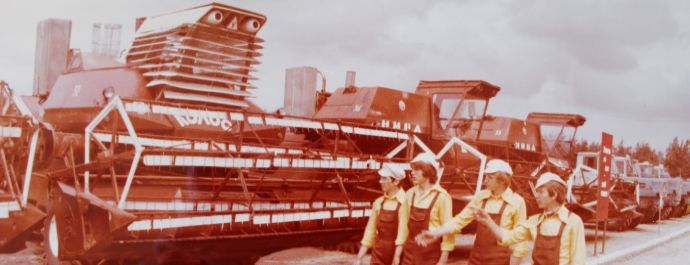
After the end of World War II, the Soviet economy was based even more than previously on industrial growth. Despite attempts for reform during the Khrushchev era, from 1953 to 1964, by the 1970s, under Leonid Brezhnev, official priorities had gone back to what they were during the Stalinist era, i.e. heavy industry, defense, agriculture and energy production in Siberia. The USSR continued to organize the distribution of industrial production between itself and its satellite countries within the framework of the Comecon (Council for Mutual Economic Assistance), created in 1949. However, behind the official propaganda that was to last until the early 1980s, consisting in a return to Stakhanovian myths and five-year plans, a few contradicting voices were raised as early as the 70s, denouncing a lasting decrease in Soviet production. Gas and oil revenues could not compensate for an aging population, energy wasted through obsolete industrial equipment, and the increasing price of massive importation of western technology. The need for reform grew with Gorbachev’s rise to power in 1985. He wanted to put measures in place allowing for massive investment in the industrial sector, improvement in production management, increases in discipline and, without naming it overtly, the possibility of returning to an open market. Policies like these necessarily required resorting to incurring exterior debt and a dramatic increase in the public deficit, which oil prices on the international market could not compensate for. The reform of industrial production during Perestroika led to the economic crisis that accompanied the collapse of the regime.
Archive
Propaganda poster for the revival of industrial production
"Let us improve quality and reinforce discipline"
country: Soviet Union / year:
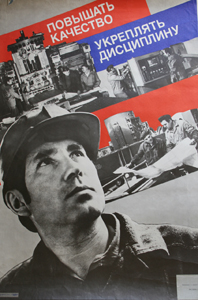
"Let us improve quality and reinforce discipline" In the mid 1970s, Soviet industry underwent a structural crisis whose contributing factors emerged slowly: the collapse in productivity was due not only to a demographic crisis and ageing machines and factories, but also to obsolete, centralized organization methods that reined in workers’ autonomy. It fell to Gorbachev, during Perestroika, to grant greater freedom in order to encourage private initiatives in reorganizing production. The outcome of these economic reforms was in fact quite limited.
Poster about benefitting from natural resources in Siberia
"Through the jungle and the marshes, we succeeded in accessing your wealth, Siberia!"
country: Soviet Union / year:
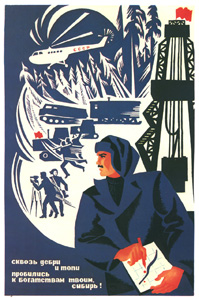
"Through the jungle and the marshes, we succeeded in accessing your wealth, Siberia!" At the head of the USSR since 1965, Leonid Brezhnev symbolized a return, after the Khrushchev years, to focusing on agriculture, heavy industry and defense. In addition, in 1972, it became necessary to get the most out of the “pioneer front in Siberia.” Located in Eastern Russia, and representing three-fourths of its land mass, Siberia, with its bitterly cold climate, possessed considerable mineral resources, particularly oil and natural gas. This policy also contributed to changing the image of a region that had hitherto been known essentially for the Gulag and the prison camps, which still existed, though not to as great an extent as during the Stalinist era.
Televisions ready to be shipped to stores
While by the 1980s, most homes were equipped with a TV, most of them were black and white and out of date, as well as being liable to implode.
country: Soviet Union / year:
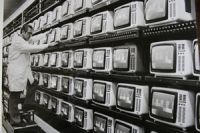
While by the 1980s, most homes were equipped with a TV, most of them were black and white and out of date, as well as being liable to implode. Stocks existed, but sales were complicated for safety reasons. As with the automobile sector 20 years earlier, the USSR turned to foreign manufacturers, including the French company Thomson, in order to build higher-quality TVs.
Poster about industrial planning
“The Party’s plans are my plans"
country: / year:
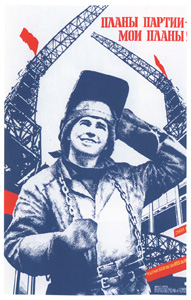
“The Party’s plans are my plans" Like his predecessors, Leonid Brezhnev, who ruled from 1964 to 1982, renewed the idea of industrial planning, the very foundation of the Soviet economy. After Khrushchev’s reformist period, Brezhnev took a more conservative course, based on reactionary concepts, focusing on patriotism and the essential role of workers rallying behind Party policy, as this poster shows. The 10th plan (1976-1980) therefore focused on production and exportation of natural resources, allowing for importation of Western machines and technology.
Energy-saving campaign in the late 80s
"At work and at home, let’s cut back.”
country: Soviet Union / year:
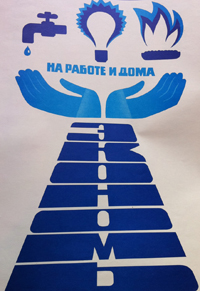
"At work and at home, let’s cut back.” The energy shortages the USSR was subjected to in 1986-1987 had two key causes: for one thing, production fell because oil and gas extraction were becoming more and more costly and complicated in Siberia, and the 1986 Chernobyl catastrophe temporarily slowed the building of new nuclear power plants, preventing an increase in electrical production. For another, the drop in oil prices on the international market obliged the USSR to reduce its own domestic consumption in order to be able to increase exports and maintain the influx of foreign currency. Since obsolete Soviet industry was energy-guzzling, and poor organization led to considerable waste, leaders had no other choice but to impose drastic energy-saving campaigns on the population – even though this necessarily led to discontent with reforms.
Postcard from East Germany showing an ad for the Trabant, the archetypal East German car
The first Trabant car to be produced by East German factories rolled off the production line in 1957, the same year as the Soviet launch of Sputnik.
country: German Democratic Republic / year:
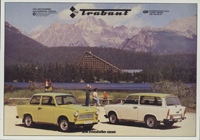
The first Trabant car to be produced by East German factories rolled off the production line in 1957, the same year as the Soviet launch of Sputnik. It was conceived as a “minimal” car, sturdy and easily repaired. In the 1980s, the wait to purchase one could be as long as 10 years. They became a status symbol within the Communist system, implying the possibility of individual “tourism” in the “brother” countries, as this postcard implies. When the Berlin Wall fell, images of Trabants leaving the Eastern bloc went around the world and would later feed into the “Ostalgia” sentiment, the feeling of nostalgia felt by East Germans after reunification.
Romanian propaganda movie on factory workers
In the early 1970s Romania was one of the least-developed countries of the Eastern Bloc
country: People’s Republic of Romania / year:
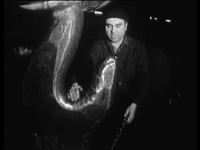
In the early 1970s Romania was one of the least-developed countries of the Eastern Bloc and the 5-year plan for 1971-1975 was aimed at encouraging industrial production. Here, Romanian television plays its role as a mouthpiece for state propaganda. The excerpt extols the iconic figure of the factory worker and of the working class conscience perpetuated from generation to generation, even, as the commentator points out, to a three-year-old child! The report does not fail to mention another icon, the woman welder, who also participates in the success of the industrial planning.
A Soviet automobile factory
Built with the help of the Italian constructor Fiat, in the 1970s, the VAZ factory
country: Soviet Union / year:
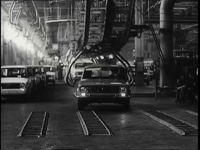
Built with the help of the Italian constructor Fiat, in the 1970s, the VAZ factory in the town of Togliatti began producing a robust car, the Jigouli, inspired by the Fiat 124. While the celebrations for the production of the three-millionth car featured Communist leaders and historical figures from the USSR on its posters, in reality it was thanks to the transfer of technologies from Western constructors, like Fiat and Renault, that Soviet automobile production accelerated. Vehicles from the firm with the somewhat complicated-looking name of AvtoVAZ were re-styled “Ladas” to facilitate sales in the West.
Soviet consultants visit the Dukovany nuclear plant in Czechoslovakia.
The Dukovany nuclear power plant, in Czechoslovakia, was built on the model of the one in Chernobyl
country: Czechoslovakia / year:
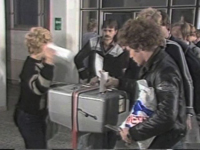
The Dukovany nuclear power plant, in Czechoslovakia, was built on the model of the one in Chernobyl, and launched in 1985. The inauguration of this first plant was overseen by Czech engineers assisted by Russian “experts.” This illustrates the “forced” economic cooperation within the Comecon, Council for Mutual Economic Assistance, which had been responsible for the specialization of national industries within the Communist bloc since 1949. The installation of this power plant had led to protest and opposition from neighboring Austria, but it has in fact functioned properly ever since.
Propaganda report on urbanization in Romania.
Still a very rural country in the 1970s, with less than half of the population living in urbanized areas, Romania was undergoing radical transformation.
country: People’s Republic of Romania / year:
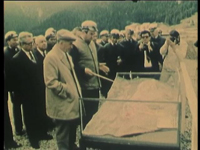
Still a very rural country in the 1970s, with less than half of the population living in urbanized areas, Romania was undergoing radical transformation. In 1967, Ceausescu’s Socialist power launched a program of “territorial systematization”, with the goal of multiplying the number of towns, especially middle-sized ones over the following 20 years. This report from the official television station praises the merits of “modern and harmonious” urbanization. In reality, rural populations where often forced to migrate to the cities, and daily life was precarious in highly indebted Romania.
Report praising the efficiency and modernity of Soviet industrial production.
This report on Soviet television glorifies the national industrial sector, which is reliant
country: Soviet Union / year:
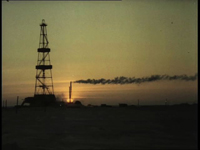
This report on Soviet television glorifies the national industrial sector, which is reliant, in the early 1980s, on steel, – of which the USSR is the number one producer worldwide – textiles, motorization and above all, energy and the extraction of natural-energy resources. In spite of this, behind the propaganda images and the endless smiles of the steel-mill workers and the textile-factory employees, the economic reality was actually much darker, with aging facilities, an insufficient workforce and low profit margins. MUTE
Official report on the modernization of Czechoslovakian agriculture
The modern combine-harvesters in this state-television report can not conceal the difficulties facing Czechoslovakian agriculture in the early 1980s.
country: Czechoslovakia / year:
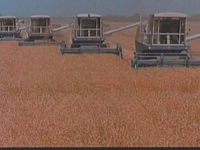
The modern combine-harvesters in this state-television report can not conceal the difficulties facing Czechoslovakian agriculture in the early 1980s. Floods, harsh winters and the scorching summer of 1979 reduced crops. Moreover, spare parts for agricultural equipment were in short supply, and Czechoslovakia was forced to increase its wheat imports, particularly from Comecon countries. However, Czechoslovakian agriculture had become much more productive by the mid-1980’s.